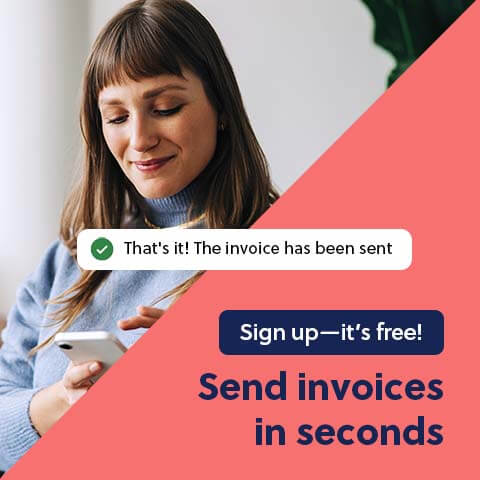Have you had a payment deadline go by without any response from your customer? Knowing what to do can be difficult, especially since you also want to maintain a good relationship with the customer. Here are some ways to handle overdue invoices.
Dealing with overdue invoices is important for your business, as late payments affect your company’s bottom line. However, it’s important to handle unpaid and overdue invoices in a way that maintains good customer relationships.
What happens when a business has a lot of overdue invoices?
When your business has a lot of overdue invoices, it’ll affect your cash flow. Since you’re not receiving the money you’re owed, you might need to put new projects on hold or you might start to find it difficult to make important purchases for your business, such as tools or packing supplies.
See also: 5 invoicing tips for beginners
When is an invoice overdue?
An invoice is considered overdue when the payment has not been received by the due date specified on the invoice. For example, if an invoice is dated March 1st with net 30 payment terms, payment should be received by March 31st. If the payment is not received by this date, the invoice is considered overdue on April 1st.
Pro-tip: Get notified about overdue invoices
The free invoicing software from Conta will let you know when a payment is overdue. You can create, send and manage invoices for free. Try it today and make your workday simpler.
How long can an invoice be overdue?
How long an invoice can be overdue depends on the policies of your business, the terms you’ve agreed with the customers, as well as legal regulations.
Generally, businesses can pursue overdue invoices for up to six years before the claim becomes invalid. After this six-year period, the customer is no longer legally obligated to pay the outstanding invoice.
5 ways to handle overdue invoices
Here are 5 things you can do if you have overdue invoices:
1. Send out a payment reminder for overdue invoices
The first thing you can do is to send a payment reminder. Some customers may not realize that due date has come and gone, they’ve simply forgotten to pay. This is often the case with overdue invoices.
You can send the payment reminder by email and remind the customers that their payment is due. You should include the amount that they have to pay, the payment terms and any late payment fees. You can send multiple reminders to highlight the importance of paying, but make sure to wait a little while between each reminder. It’s also a good idea to attach a copy of the original invoice for reference.
Here’s an example of reminder email:
Subject: Friendly reminder: Invoice [invoice number] is due for payment
Dear [customer name],
I hope this message finds you well.
I’m writing to remind you that invoice [invoice number], dated [invoice date], is now overdue. The total amount due is [amount due], and the payment was due on [due date].
We understand that oversights happen, and we would appreciate your prompt attention to this matter. Below are the details of the invoice for your reference:
– Invoice number: [invoice number]
– Invoice date: [invoice date]
– Due date: [due date]
– Amount due: [amount due]
In order to pay, please use the information in the attached invoice.
If you’ve already paid, you can disregard this reminder. We would appreciate you letting us know or forwarding the payment confirmation to us.
Should you have any questions or require any assistance, please don’t hesitate to contact us.
2. Make a phone call
You might not get a response when you send a payment reminder. It’s a good idea to call the customers to see if there are any problems with the payment. This also allows you to discuss the issue with them, and hopefully arrive at a solution.
Remember that it’s important to stay polite and professional in the phone call, and you should avoid accusing the customer of paying late on purpose. You want to keep a good working relationship with them so that they continue to purchase from you in future.
3. Charge a late fee
A late fee is an additional charge for a delayed payment. You can only charge a late fee if you’ve clearly communicated your late fee policy to the customer and they’ve agreed to it in writing. The invoice you’re sending should also state the late fee policy clearly. You can charge a flat fee for late payments or a percentage of the total amount.
Avoid disputed invoices with Conta
Invoicing errors can cause disputes between businesses and customers. Conta provides the solution by streamlining the invoicing process, decreasing the probability of errors and giving you peace of mind.
Simply enter the customer details, along with the product and pricing information, and effortlessly send your polished and professional invoice.
4. Extend credit
There could be various reasons that a customer is paying late. When you’ve talked to the customer, you should consider extending the deadline or setting up a payment plan.
For example, instead of requiring an immediate $8000 payment, you could allow the customer to pay in monthly installments across ten months. However, keep in mind that letting the customer pay you in instalments can negatively impact your cash flow.
Alternatively, you could accept a partial payment of $6000 upfront and arrange a payment plan for the remaining $2000.
See also: The ultimate guide to liquidity and cash flow
5. Take legal action
If you have overdue invoices where customers owe you a significant amount of money, you could take legal action. Gather all the documents, the invoice, payment reminders, other written communication between you and the customer, and seek help from a professional. Taking legal action not only increases the possibility of getting paid, but it also shows that your business operates in a professional manner.
If the overdue payment is a small sum of money, businesses often write off the invoice instead.

How to avoid overdue invoices
Getting paid on time helps your business maintain a healthy cash flow and ensures financial stability. Overdue invoices can disrupt your operations and strain your relationships with customers. To minimize the risk of overdue invoices, here are some effective strategies:
Be clear about how the customer should pay you
To avoid overdue invoices, you should establish clear payment terms. Make sure to outline all payment terms and conditions, so that both parties understand their responsibilities.
Here are some things to include:
- Payment terms: Clearly state the payment due date. Example could be «Net 30 days from invoice date». You should also specify if there are any early payment discounts or late payment penalties.
- Payment methods: List the acceptable payment methods, like bank transfer, credit card, or PayPal. Provide necessary instructions for how to pay via each payment method.
- Late fees and penalties: Clearly outline any late fees or penalties for overdue payments.
- Documentation: Make sure that both parties sign the agreement to acknowledge and accept the terms. Get a copy of the signed agreement, and give one to the customer as well.
See also: How to make an invoice
Use invoicing software
Using invoicing software can reduce the risk of overdue invoices by streamlining the whole invoicing process. You can create and send invoices quickly, ensuring timely delivery to your customers. Invoice software also help you ensure that you’re including everything you should on the invoice, and provides you with a professional looking invoice template. Lastly, invoice software helps with record-keeping, as all your invoices are safely stored in one place.
Conta is a free invoicing software for all businesses, no matter the size or industry. We are trusted by over 200 000 businesses worldwide, and rated 4.5 on Google. You can create an invoice in just a few minutes!
Sign up for freeCustomer relationship
Building and maintaining strong customer relationships is the key to timely payments. Make sure to establish clear lines of communication from the get-go. Your clients should understand the payment terms, due dates and payment method. Check in with your customers regularly to see if they are satisfied with your services and address any issues promptly.
To avoid overdue invoices, you should provide high-quality services to build trust and loyalty. Satisfied customers are more likely to prioritize paying your invoices. Another tip is to send thank-you notes or follow-up emails after a project is completed to show your appreciation.
See also: Creating an invoice for freelance work: A complete guide
Advance payments help avoid overdue invoices
Requesting advance payments is an effective strategy to secure good cash flow and reduce the risk of overdue invoices. By collecting a portion of the payment upfront, you can ensure that you have the necessary funds to start projects and cover initial costs.
Typically, an advance payment ranges from 20-50 percent of the total project cost, depending on the nature and scope of the work. You should figure out a percentage that covers your initial expenses and mitigates financial risk. For longer-term projects, consider setting milestones and requiring partial payments as each milestone is completed.
Create free invoices with Conta
Say goodbye to the hassle of creating invoices! Conta streamlines the process, allowing you to breeze through it in under 2 minutes. Just enter customer details, along with product and price information, and quickly send your professional invoice.
Offer several payment options
Providing different payment options can help ensure timely payments and reduce the likelihood of overdue invoices. By making the payment process as convenient as possible for your customers, you increase the chances of them paying on time. Here are some ways to implement different payment options:
- Accept major credit and debit cards: This is one of the most common and convenient payment methods. Use a secure payment gateway to process card payments efficiently and safely.
- Online payment platforms: Offer payment options through platforms like PayPal, Stripe, or Square. These platforms provide a quick and easy way for clients to pay you. Integrate these payment options directly into your invoices to make it a seamless process.
- Bank transfers and direct deposits: Allow clients to make payments via bank transfer or direct deposit. Provide clear instructions, including your bank account details, IBAN, and SWIFT/BIC codes if necessary. Make sure to confirm the payment as soon as you receive it, to reassure clients.

Managing overdue invoices is important to maintain the financial health of your business. By implementing clear payment agreements, using invoicing software, fostering strong customer relationships, requesting advance payments, and offering several payment options you can significantly reduce the chances of overdue invoices.
Furthermore, these strategies not only ensure timely payments but also help maintain a positive relationship with your customers, promoting long-term business success.






